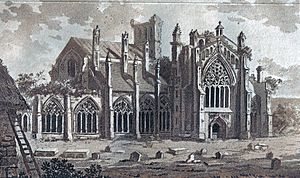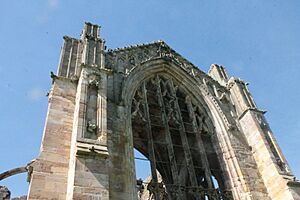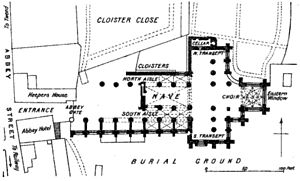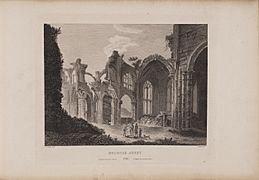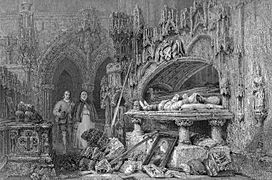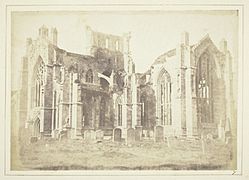Melrose Abbey facts for kids
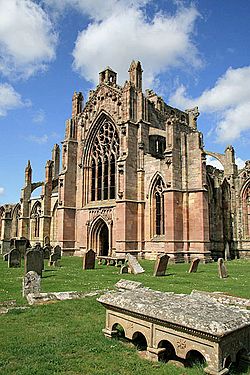 |
|
| Monastery information | |
|---|---|
| Order | Cistercian |
| Established | 1136 |
| Disestablished | 1609 |
| Mother house | Rievaulx Abbey |
| Diocese | Diocese of Glasgow |
| Controlled churches | Cavers Magna; Dunscore; Ettrick; Hassendean; Mauchline; Melrose; Ochiltree; Tarbolton; Westerkirk; Wilton |
| People | |
| Founder(s) | David I of Scotland |
| Important associated figures | Waltheof, Jocelin |
| Site | |
| Location | Melrose, Scottish Borders |
Melrose Abbey is a beautiful old building in Melrose, Scotland. It used to be a monastery, which is a place where monks live and pray. This abbey was built by a group of monks called the Cistercian order in 1136. King David I of Scotland asked them to build it.
Melrose Abbey was once the most important Cistercian monastery in Scotland. Today, parts of it are in ruins, but it's still looked after by Historic Environment Scotland. You can visit it and explore its history.
The abbey was built in a style called Gothic, which means it has tall arches and detailed carvings. It's famous for its many decorative carvings. You can see saints, dragons, gargoyles, and plants carved into the stone. One special carving on a stairway says, Be halde to ye hende, which means "Keep in mind, your final goal." This became the motto for the town of Melrose.
Many important Scottish kings and nobles are buried here. One of the most famous stories is about the heart of Robert the Bruce. It's believed his heart was buried at Melrose Abbey, while the rest of his body is at Dunfermline Abbey.
Contents
Exploring Melrose Abbey's Past
The First Monastery: Old Melrose
Long before the current Melrose Abbey, there was an even older monastery. It was founded by Saint Aidan of Lindisfarne around the year 651. This first monastery was about two miles east of where the abbey stands today.
A famous saint named Cuthbert (who died in 687) grew up nearby. He trained at Old Melrose Abbey and later became a leader there. This old site is now marked by a graveyard.
Building the Cistercian Abbey
Melrose Abbey was the very first Cistercian abbey in Scotland. King David I wanted it built in a certain spot, but the Cistercian monks chose a different location. They said the original land wasn't good enough for farming.
The main church of the abbey was finished and dedicated to St. Mary in 1146. The monks who started Melrose Abbey came from another monastery called Rievaulx Abbey in England.
In the 1100s, the Cistercian monks at Melrose were very good farmers. They used new techniques and sold their wool all over Europe. A town slowly grew up around the abbey. At one point, during a time of hunger, the monastery fed 4,000 starving people for three months!
The abbey became very rich and powerful. Many of its leaders, called abbots, were important people. Waltheof of Melrose, who was the king's stepson, was an abbot here. He made Melrose famous for its holiness and learning. People even came on pilgrimages to visit his tomb.
Attacks and Rebuilding
Melrose Abbey was located on a main road, which made it easy to attack during wars.
- In 1322, the English army led by King Edward II attacked the town. Much of the abbey was destroyed.
- Robert the Bruce ordered the abbey to be rebuilt after this attack.
- In 1385, the abbey was burned again by the English army of Richard II of England. It took about 100 years to rebuild it!
- In 1544, during more wars between Scotland and England, the abbey was badly damaged once more. It was never fully repaired after this.
The last monk at Melrose Abbey died in 1590. The abbey was later attacked by Oliver Cromwell's troops. You can still see cannonball marks on some of its walls.
In 1618, part of the abbey church was turned into a local church for the town. It was used until 1810.
Saving the Ruins
In the early 1800s, a famous writer named Sir Walter Scott helped save the abbey. With money from the Duke of Buccleuch, Sir Walter oversaw important repair work. In 1918, the duke gave the ruins to the Scottish government. Now, Historic Environment Scotland takes care of this amazing historical site.
The Heart of Robert the Bruce
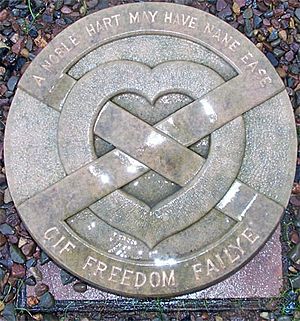
The story goes that the heart of Robert the Bruce, a famous Scottish king, was buried at Melrose Abbey. This might have happened around 1330 or 1331. A small metal plaque used to mark the spot.
In 1996, archaeologists found a lead container and a copper plaque. The plaque said, "The enclosed leaden casket containing a heart was found beneath Chapter House floor, March 1921..." Inside the casket was a human heart. Since there are no records of anyone else's heart being buried there, people believe it belongs to Robert the Bruce.
The container was reburied at Melrose Abbey on June 22, 1998, under a special memorial stone.
What Melrose Abbey Looks Like
Melrose Abbey is built in a long shape, running from east to west. The western part is mostly gone, with only its foundations remaining. The eastern part is much more complete.
There's a graveyard for the local community to the south and southeast of the abbey. Most of the gravestones are from the 1800s. Melrose Abbey is special because it's the only Scottish abbey that still has some of its original floor tiles!
Abbots of Melrose Abbey
Here are some of the important leaders, called abbots, who guided Melrose Abbey:
- Eata was the first abbot.
- Richard Lambe was abbot in 1473.
- Robert Betoun was abbot in 1519.
- Thomas Ker was abbot in 1524.
- William Ker was a commendator (a type of abbot) who died before 1566.
- Michael Balfour was a commendator in 1568.
- James Douglas was abbot and commendator from 1569 to 1606.
Gallery
Famous Burials at the Abbey
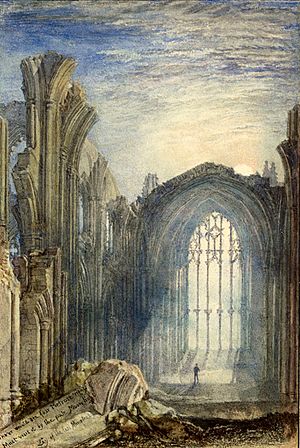
Many important people were buried at Melrose Abbey, including:
- Jocelin (Bishop of Glasgow)
- Waltheof of Melrose
- Alexander II of Scotland, a Scottish king
- William Douglas, 1st Earl of Douglas
- Sir David Brewster, who invented the Kaleidoscope
- Members of the Buccleuch family, who helped preserve the abbey
Melrose Abbey in Culture
- The writer Sir Walter Scott wrote about Melrose Abbey in his poem, "The Lay of the Last Minstrel."
- A church in Michigan, USA, called Kirk in the Hills, was built in a Gothic style and looks like Melrose Abbey.
- The abbey was even built in the video game Minecraft by 4J Studios in 2015! It was part of one of the game's official tutorial worlds.
Visiting Melrose Abbey Today
Melrose Abbey is part of the Borders Abbeys Way, a walking trail that connects several historic abbeys in Scotland. In 2019, over 61,000 people visited the site.
As of early 2023, some parts of the church are closed for conservation work. However, visitors can still explore the cloisters, museum, and gardens. It's a great place to learn about Scottish history and see amazing old architecture!
See also
 In Spanish: Abadía de Melrose para niños
In Spanish: Abadía de Melrose para niños
- Abbot of Melrose, for a list of the abbey's leaders
- List of religious houses in Scotland
- List of places in the Scottish Borders
- List of places in Scotland


